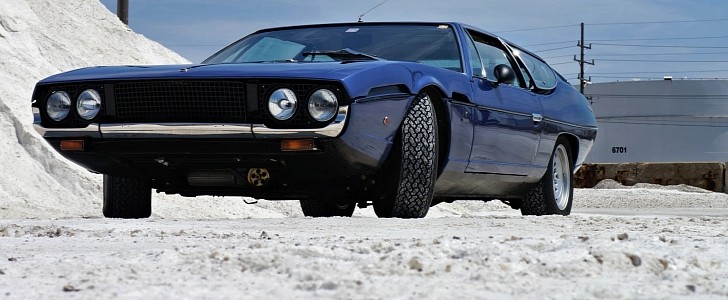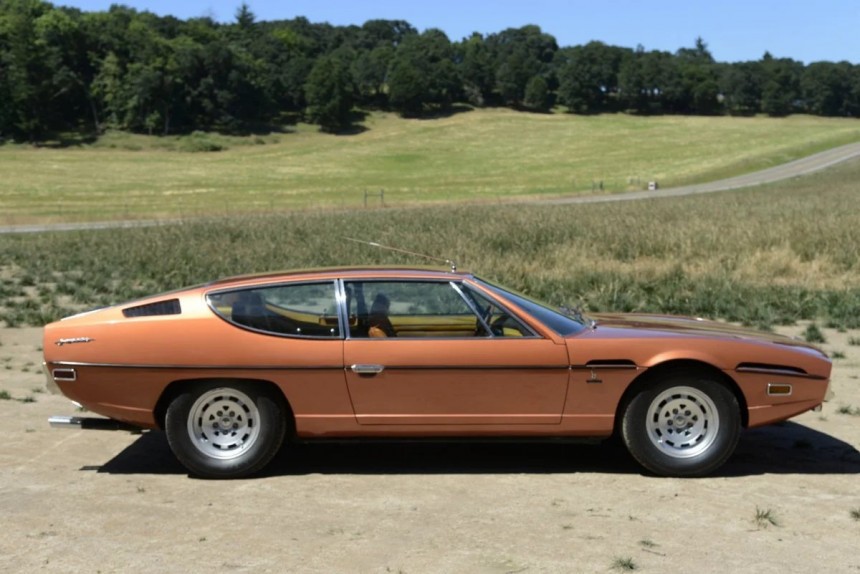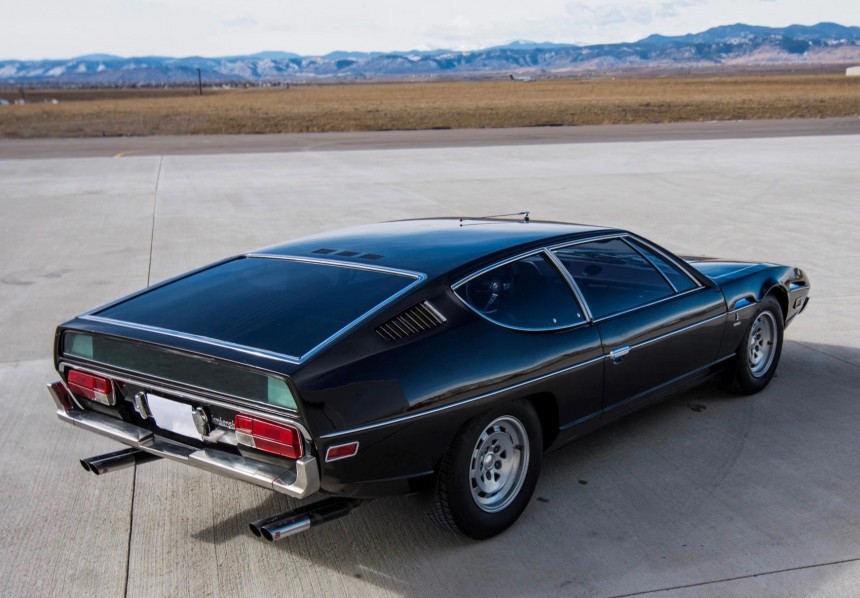Unveiled at the 1967 Geneva Motor Show, the Marzal penned by Marcello Gandini at Bertone laid the groundwork for the Raging Bull’s next gran turismo. Equally impacted by the Jaguar Pirana by Bertone presented at the 1967 London Motor Show, the Espada was produced to the tune of 1,227 units. The Countach would subsequently top this volume.
Ferruccio Lamborghini wasn’t a big fan of the glass panels in the gullwing doors of the Marzal. During a visit to the Bertone Design Studio, the big kahuna laid eyes on the Pirana, and that’s when the puzzle fell into place. Considering that Ferruccio tasked Franco Scaglione and Giorgio Prevedi to draw inspiration from the front end of the Jaguar E-Type for the front end of the 350 GTV, the Pirana’s influence on the Espada is understandable.
A roomier alternative to the 400 GT-based Islero that was introduced at the 1968 Geneva Motor Show alongside the Espada, this bull isn’t named after a bull. Espada is the sword used by a matador, and given the car’s side profile, the moniker fits like a glove in hand. A rival for the Ferrari 365 GT 2+2 and later four-seat grand tourers such as the Maserati Kyalami, the most spacious Lamborghini of that era is rocking a steel monocoque bodyshell.
Gifted with a 2,650-millimeter wheelbase compared to 2,550 millimeters for the Islero and 2,500 millimeters for the Miura, the Espada features double-wishbone front and rear suspension. Lamborghini experimented with Lancomatic hydropneumatic self-leveling rear suspension, but at the end of the day, the contraption was deemed too expensive and unreliable.
Coil springs, telescopic dampers, and anti-roll bars complement Girling disc brakes that measure 300 and 280 millimeters, respectively. The servo-assisted brakes are obscured by 15-inch magnesium alloys supplied by Campagnolo. The center-lock wheels were originally shod with Pirelli Cinturatos.
As opposed to the mid-mounted transverse V12 of the Miura, the Espada’s engine is a longitudinal affair mounted in front of the passenger cell. Fed by two fuel tanks located on either side of the trunk compartment, the 3.9-liter engine was designed by none other than Giotto Bizzarrini. Instrumental in the development of the Alfa Romeo Giulietta and Ferrari 250 GTO, the Italian engineer wouldn’t have guessed that Lamborghini would use his 12-cylinder architecture until 2010 when the Aventador was discontinued.
Modified with side-draft carburetors and a 9.5:1 compression ratio instead of downdrafts and 9.8:1 for the higher-performing Miura, the Espada originally produced 325 horsepower and 276 pound-feet (374 Nm) at 4,500 revolutions per minute. The second iteration of the Espada, dubbed Series II or S2, has reshaped combustion chambers, high-lift camshafts, a 10.7:1 compression ratio, and larger inlet ports. These upgrades leveled up the output to 350 horsepower and 290 pound-feet (393 Nm) at 5,500 rpm.
Presented at the 1970 Brussels Motor Show, the Espada S2 was updated once again in 1972 with the Espada S3 that carries over the 350-pony engine of its predecessor. The third iteration was offered with a Chrysler-sourced TorqueFlite three-speed automatic transmission. Only 55 automatics were delivered. The rest of the production run features the five-speed manual.
Tipping the scales at just over 1,600 kilograms (3,527 pounds), the Espada hits 100 kilometers per hour (62 miles per hour) in six-odd seconds. Although it gained 10 kilograms (22 pounds) for the second series, straight-line performance remained unchanged. All three series can effortlessly reach 250 kilometers per hour (155 mph) with the five-speed stick shift.
Fitted as standard with electric windows, the Espada S1 numbers only 187 units. Four of them were finished in right-hand drive. Early on during production, the Raging Bull of Sant’Agata Bolognese decided to improve the front and rear headroom by lowering the floorpan by 20 millimeters.
The Espada S2 totals 575 examples, of which 51 were delivered in right-hand drive. This variant switched from center-lock wheels to the five-lug wheels used by the Jarama S in the spring of 1972. Just like the center locks, these wheels were manufactured from magnesium alloy by Campagnolo.
Introduced at the 1972 Turin Auto Show, the Espada S3 tallies 465 units. Distinguished by Alfa Romeo 2000 taillights and a square mesh front grille, the final run came standard with power steering and air conditioning.
Based on an Espada S2, the Frua Faena is a stretched Espada with four doors and Citroen SM taillights, bodied by Italian coachbuilder Pietro Frua. Revealed in 1978 at the Turin Motor Show, the most practical and heaviest Espada of them all was sold to a German collector by the name of Erich Klinge. Offered for sale in 2003 at Lamborghini’s 40th Anniversary Celebration, the one-off car was eventually purchased by renowned Swiss collector Albert Spiess.
A roomier alternative to the 400 GT-based Islero that was introduced at the 1968 Geneva Motor Show alongside the Espada, this bull isn’t named after a bull. Espada is the sword used by a matador, and given the car’s side profile, the moniker fits like a glove in hand. A rival for the Ferrari 365 GT 2+2 and later four-seat grand tourers such as the Maserati Kyalami, the most spacious Lamborghini of that era is rocking a steel monocoque bodyshell.
Gifted with a 2,650-millimeter wheelbase compared to 2,550 millimeters for the Islero and 2,500 millimeters for the Miura, the Espada features double-wishbone front and rear suspension. Lamborghini experimented with Lancomatic hydropneumatic self-leveling rear suspension, but at the end of the day, the contraption was deemed too expensive and unreliable.
Coil springs, telescopic dampers, and anti-roll bars complement Girling disc brakes that measure 300 and 280 millimeters, respectively. The servo-assisted brakes are obscured by 15-inch magnesium alloys supplied by Campagnolo. The center-lock wheels were originally shod with Pirelli Cinturatos.
Modified with side-draft carburetors and a 9.5:1 compression ratio instead of downdrafts and 9.8:1 for the higher-performing Miura, the Espada originally produced 325 horsepower and 276 pound-feet (374 Nm) at 4,500 revolutions per minute. The second iteration of the Espada, dubbed Series II or S2, has reshaped combustion chambers, high-lift camshafts, a 10.7:1 compression ratio, and larger inlet ports. These upgrades leveled up the output to 350 horsepower and 290 pound-feet (393 Nm) at 5,500 rpm.
Presented at the 1970 Brussels Motor Show, the Espada S2 was updated once again in 1972 with the Espada S3 that carries over the 350-pony engine of its predecessor. The third iteration was offered with a Chrysler-sourced TorqueFlite three-speed automatic transmission. Only 55 automatics were delivered. The rest of the production run features the five-speed manual.
Tipping the scales at just over 1,600 kilograms (3,527 pounds), the Espada hits 100 kilometers per hour (62 miles per hour) in six-odd seconds. Although it gained 10 kilograms (22 pounds) for the second series, straight-line performance remained unchanged. All three series can effortlessly reach 250 kilometers per hour (155 mph) with the five-speed stick shift.
The Espada S2 totals 575 examples, of which 51 were delivered in right-hand drive. This variant switched from center-lock wheels to the five-lug wheels used by the Jarama S in the spring of 1972. Just like the center locks, these wheels were manufactured from magnesium alloy by Campagnolo.
Introduced at the 1972 Turin Auto Show, the Espada S3 tallies 465 units. Distinguished by Alfa Romeo 2000 taillights and a square mesh front grille, the final run came standard with power steering and air conditioning.
Based on an Espada S2, the Frua Faena is a stretched Espada with four doors and Citroen SM taillights, bodied by Italian coachbuilder Pietro Frua. Revealed in 1978 at the Turin Motor Show, the most practical and heaviest Espada of them all was sold to a German collector by the name of Erich Klinge. Offered for sale in 2003 at Lamborghini’s 40th Anniversary Celebration, the one-off car was eventually purchased by renowned Swiss collector Albert Spiess.






























































